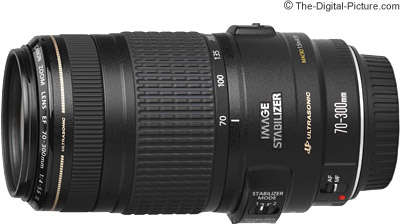
Brand New Canon EF 70-300mm f/4-5.6 IS USM Lens
Check my rate
| Main centres: | 1-3 business days |
| Regional areas: | 3-4 business days |
| Remote areas: | 3-5 business days |

| Main centres: | 1-3 business days |
| Regional areas: | 3-4 business days |
| Remote areas: | 3-5 business days |
Brand new and sealed in the box
With the introduction of the Canon EF 70-300mm f/4-5.6 IS USM Lens, Canon has replaced one of its most popular lenses and its first image stabilized lens - the Canon EF 75-300mm f/4.5-5.6 IS. The 75-300mm IS lens was popular because of its useful focal length range, small size, light weight, midrange price and Image Stabilization. The Canon EF 70-300mm f/4-5.6 IS USM Lens improves this overall package (sacrificing only price somewhat).
Sporting a 3rd generation image stabilizer, the Canon EF 70-300mm f/4-5.6 IS USM Lens is designed to be handholdable at a shutter speed up to 3 f-stops slower than a non-stabilized lens at the same focal length. "Gyro sensors detect unwanted vibrations, triggering the corresponding movement of a correcting lens group perpendicular to the optical axis. This alters the light path, returning the image to its correct position on the sensor or film plane." [Canon]
Using the 1/(focal length) rule, this lens can be handheld at 300mm with a shutter speed of 1/45 of a second (of course, your mileage may vary). I am getting sharp handheld images consistently at 1/4 or 1/5 second shutter speeds at 70mm and at 1/25 second at 300mm on a full frame body. All of the 70-300 IS sample pictures (link below) were taken handheld.
Automatic tripod sensing prevents "... feedback loops between the IS sensor and stabilizer motor vibrations" [Canon]. This implementation of IS includes Mode 1 and 2 stabilization. Use mode 1 (dual axis stabilization) when shooting stationary subjects and mode 2 (single axis stabilization) when panning with a moving subject. The IS switches are recessed to prevent accidental changes - a nice improvement. In my opinion, image stabilization is the best feature of this lens. It is a significant help when shooting stationary subjects without a tripod.
Image stabilization is especially helpful to a slow (narrow aperture) lens. Slow is relative of course - the Canon EF 70-300mm f/4-5.6 IS USM Lens apertures are typical for a consumer telephoto zoom lens. The chart below shows the focal length that triggers a maximum aperture decrease to that listed in the column heading above for each lens.